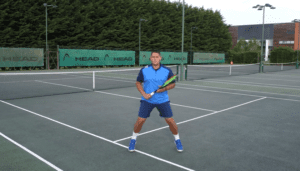
Dominic Thiem Tennis Forehand Evolution – Thiem Forehand Analysis
Dominic Thiem Tennis Forehand Evolution – Thiem Forehand Analysis
Dominic Thiem has become one of the best tennis players in the world.
Threatening the dominance of the big three, Roger Federer, Rafa Nadal, and Novak Djokovic.
Thiem recently won his first grand slam title at the 2020 US Open and looks set to be a future world number one.
One of Dominic Thiem’s biggest weapons in his tennis is his forehand.
Thiem’s forehand technique has evolved over the years, the difference between his 2014 forehand and his 2020 forehand is very evident.
In this free tennis lesson, coach Simon Konov of Top Tennis Training will break down and analyze the changes that Dominic Thiem has made to his forehand between 2014-2020.
The Evolution of Thiem’s Tennis Forehand 2014-2020
In 2014, Thiem had a very powerful forehand, capable of producing big winners and hitting heavy topspin.
However, he struggled with timing on the faster court surfaces such as the grass at Wimbledon and the indoor hard courts.
Thiem required a lot of time to set up with his big loop.
A circular swing that required Thiem to stay 6-8 feet behind the baseline so he would have the time to prepare properly.
That’s why Thiem’s best results were coming on clay courts and slower hard courts.
However, in 2019, Thiem started to modify his forehand technique to make the swing more compact.
Dominic Thiem’s 2020 Forehand – Thiem made three major changes to his forehand in 2019:
- The starting position, in particular, the tip of the racket pointing upwards instead of towards the net.
With Thiem’s older forehand technique, the tip of the racket would be pointing down the court. - The elbow still creates space in the preparation of Thiem’s forehand, but it doesn’t lead the swing as it did.
- The size of the swing. With his older forehand, the swing was very big, but his new forehand is much more compact.
These three changes have allowed Thiem to be much more aggressive with his court positioning.
Thiem can now take the ball on the rise, dictating points from close to or inside the baseline.
This has reduced the amount of court he has to cover.
It also helps Thiem take time away from his opponents which he has used to great effect at the 2020 US Open in New York.
Video Timeline:
00:00 – Dominic Thiem Forehand Evolution Intro
00:26 – Dominic Thiem’s Forehand 2014-2018
2:10 – Why Big Swings Don’t Work On Fast Courts
3:10 – The Modern Style Tennis Forehand
4:32 – Thiem’s New Forehand Power Position
6:08 – Thiem’s Court Positioning 2020
8:46 – Video Outro



